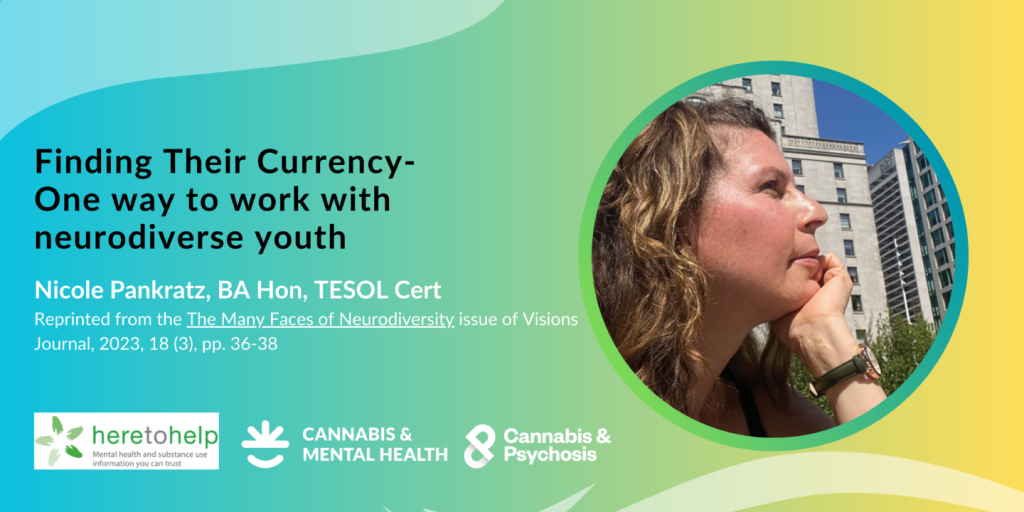
In the late 1990s I worked as an English teacher at an international school in downtown Vancouver. I didn’t know the term neurodiversity back then. All I knew was that a young man from Japan in my Level 1A class could communicate but could not pass the written test needed to move on to the next level.
Yoshi was in my class three times. Each time, he entertained the class with stories told through body language, pictures on the whiteboard and a few English expressions. But when it came to test time, he couldn’t fill in enough blanks or circle enough right answers. I was ashamed I hadn’t helped him succeed. I suggested trying a different class with a different teacher. Instead, he asked if I would tutor him.
Tailored tutoring to reach youth
During our 90-minute, twice-a-week sessions, I learned a lot about Yoshi. For instance, he worked as an assistant mechanic at his father’s business in Japan. And he paid his rent by working as a human statue on Robson Street. When he showed me his long white gown, I was taken aback. I’d passed by his performance many times but hadn’t recognized his face under his heavy makeup.
I worked with Yoshi for two months. Then I took on other students who said they didn’t feel right in the regular system. Each session, I focused on practising language skills, but I also wrote down what we talked about in a notebook the students could keep and review later—our own evolving textbook. The students learned only what was relevant to them.
We practised everyday expressions and conversation at native-speaker speed to improve their chances of befriending same-aged Canadians. Often I’d send students into cafés or stores where they had to use what they’d learned on native English speakers. I’d wait outside to hear how it went. I loved seeing them come out smiling. It meant they were proud of themselves. If they came out looking embarrassed, we’d discuss it and I’d usually encourage them to try somewhere else.
Leaving no youth behind
A decade later I was a mom taking care of kids and step-kids, one of whom struggled with basic literacy skills. Nobody knew exactly why she struggled. But all the adults around her seemed to believe she had a disability that would prevent her from succeeding at school. I didn’t believe that, and I didn’t think it was right to give up on her.
At the time, I was still working as a tutor and also as a home-based writer. When I wasn’t working, I created games and activities suitable for a group of kids of varying ages and abilities. That way, my stepdaughter could participate without standing out.
One summer I gathered kids from the neighbourhood and launched a multi-age literacy program called the Ladybug Club. I appointed my stepdaughter as my helper, thinking she might be inspired by the sense of responsibility. I was searching for her currency—something that would motivate her to want to spend time learning at the level of her peers. She enjoyed having younger kids look up to her, but she didn’t put much effort into the activities.
As she approached her teenaged years though, she wanted to use social media and participate meaningfully in a youth group. That’s when she saw that it was worth working hard at reading and math, even though it was challenging. She pushed herself to graduate from high school at the same time as her friends, and with good enough grades to get into post-secondary programs. She showed that with determination and support, it’s possible for youth to reach goals that are important to them.
Looking back, it seems that what worked best with all types of youth I worked with was: (a) focusing on what mattered to the student and (b) making the experience as enjoyable as possible.
Side School
In the fall of 2022 I used what I’d learned to create Side School, a trauma-informed tutoring service designed for youth ages 10–18 who are not in school or have few connections to school.
Side School1 offers one-hour tutoring sessions in coffee shops, malls and other public spaces. Each lesson, facilitated by outreach workers, leads with a spark—a song, story, game or other type of conversation starter. Next, we use a set of questions from a style of learning called philosophical inquiry. These are open-ended questions that guarantee there are no “right answers,” but rather, offer youth and adults the chance to share thoughts and feelings.
After that, we have optional extension activities. These encourage creative expression in the form of artwork, writing, music or a follow-up project. All the activities build on the youths’ ideas and strengths. Youth participants are given a gift card for each hour they spend meaningfully engaging in Side School conversations and activities.
Youth with considerable challenges, including homelessness, mental health problems and substance use issues, can feel at ease with Side School. That’s because it’s a non-judgmental program committed to letting them take the lead. They decide where conversations and activities go. For neurodiverse students, like those with ADHD or autism spectrum disorder, Side School provides an opportunity to focus on a topic and task, even if it’s something they don’t particularly like.
The philosophical questions may encourage them to think about things they aren’t used to talking about. And many of the activities invite them to use their neural differences as advantages in learning and expressing themselves. For example, one project asks youth to offer solutions to an ecological problem involving teens and others who use tobacco or cannabis (like what to do about discarded cigarette butts and roaches). Another project addresses gaps in youth housing and services. Several lessons are based on exploring song lyrics, identifying themes that matter to youth and bringing metaphors to life through art.
Some neurodiverse youth have struggled with the questions in their Side School lessons. Some have said they haven’t been asked questions like that before and they needed time to think about them. But in the end, they’ve said they enjoy the conversations. Those helping with the youth housing challenge showed appreciation for having their ideas put down in writing. They said they believe their suggestions will help other youth. One student even contributed to the collection of Side School lessons by writing a complex poem for others to discuss.
The Side School approach can help build a trusting relationship between a caring adult and a youth. It gives the adult ample opportunity to model respectful dialogue and compliment the youth for their insights, knowledge and efforts.
Youth benefit by being respectfully listened to and taken seriously. And they’re paid for their sincere contributions. For youth dealing with big challenges, you could say their currency is real currency, in the form of gifts cards for grocery stores or their favourite shops. To find out more about Side School, contact me at niki@cannabisandmentalhealth.ca.
Related Resources
Side School lessons are based on ideas borrowed from a range of Indigenous and non-Indigenous health promotion resources. These include:
- A Life Promotion Toolkit by Indigenous Youth, prepared by the Thunderbird Partnership Foundation: wisepractices.ca/life-promotion-toolkit
- The Cannabis and Mental Health Course and Mentor Guide, prepared by the Schizophrenia Society of Canada in partnership with the Mental Health Commission of Canada and YouthREX: cannabisandmentalhealth.ca
- iMinds, a collection of K–12 drug and gambling literacy resources prepared by the Canadian Institute for Substance Use Research: uvic.ca/research/centres/cisur/publications/helping-schools/iminds/index.php
About the author
Nicole works as a community engagement coordinator and youth support worker at Tillicum Lelum Aboriginal Friendship Centre in Nanaimo, BC. She’s also a freelance writer and curriculum developer
Footnotes:
- Side School has been supported with a small grant from the Nanaimo Community Action Team (CAT) on the opioid overdose crisis, which is funded by the BC Ministry of Mental Health and Addictions.



